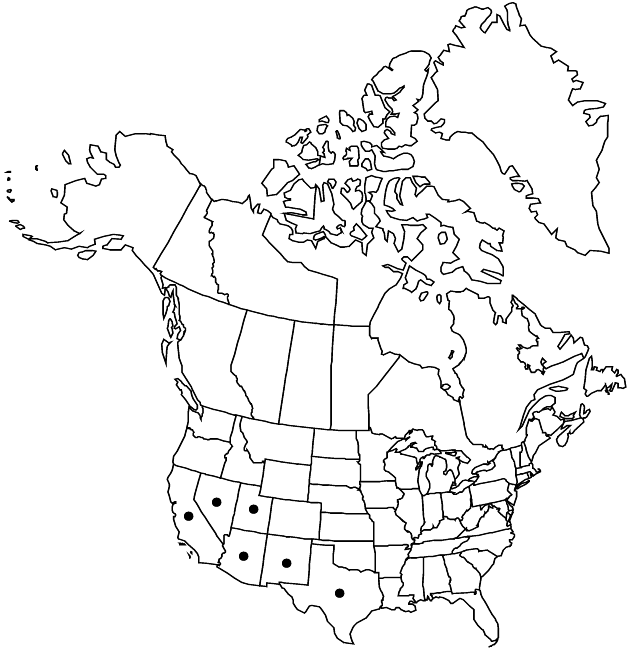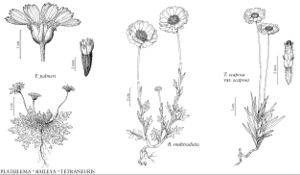Difference between revisions of "Baileya multiradiata"
Mem. Amer. Acad. Arts, n. s. 4: 106. 1849.
FNA>Volume Importer |
FNA>Volume Importer |
||
| Line 67: | Line 67: | ||
|publication year=1849 | |publication year=1849 | ||
|special status= | |special status= | ||
| − | |source xml=https://jpend@bitbucket.org/aafc-mbb/fna-data-curation.git/src/ | + | |source xml=https://jpend@bitbucket.org/aafc-mbb/fna-data-curation.git/src/f50eec43f223ca0e34566be0b046453a0960e173/coarse_grained_fna_xml/V19-20-21/V21_1117.xml |
|tribe=Asteraceae tribe Heliantheae | |tribe=Asteraceae tribe Heliantheae | ||
|subtribe=Asteraceae (tribe Heliantheae) subtribe Gaillardiinae | |subtribe=Asteraceae (tribe Heliantheae) subtribe Gaillardiinae | ||
Revision as of 20:33, 16 December 2019
Plants mostly 20–100 cm. Leaves: basal (rosette) leaves mostly 3–10 × 1–5 cm; petioles 1–4 cm; blades ovate, usually pedately to pinnately lobed (cauline leaves in vernal forms much reduced; autumnal forms often leafy throughout and cauline leaves not much reduced). Heads borne singly. Peduncles 10–30 cm (vernal forms, often shorter on autumnal forms). Involucres hemispheric (vernal forms), mostly 5–10 × 10–25 mm. Phyllaries mostly 21–34, floccose-tomentose. Rays (vernal forms) mostly 34–55; laminae linear-oblanceolate, mostly 10–20 × 5 mm, apices moderately to deeply 3-toothed. Disc florets (vernal forms) 100+; corollas 4 mm, tubes 1 mm, lobes 0.25 mm; style-branch apices truncate to slightly rounded. Cypselae 4 mm. 2n = 32.
Phenology: Flowering Mar–Nov (depending on rains).
Habitat: Stony slopes, mesas, and sandy plains
Elevation: 100–2000 m
Distribution

Ariz., Calif., Nev., N.Mex., Tex., Utah, Mexico (Aguascalientes, Chihuahua, Coahuila, Durango, Sonora).
Discussion
Baileya multiradiata is an attractive and bountiful wild flower over a large part of the desert Southwest. It has been touted as a promising plant for landscaping, and research on its nursery production has begun (D. J. Cotter et al. 1980, 1982).
Both Baileya multiradiata and B. pleniradiata produce an antineoplastic pseudoguaianolide, radiatin, which might prove useful in cancer therapy (J. J. Einck et al. 1978). In addition, the antibiotic sesquiterpene lactone, baileyolin, from B. multiradiata inhibits tumor formation (X. A. Dominguez et al. 1977).
Baileya multiradiata is reportedly toxic to livestock, especially to sheep and goats, where losses as high as 25% have been reported on overgrazed rangeland in Texas (D. W. Hill et al. 1979, 1980). Cattle and horses seem to be unaffected, or at least poisoning of these animals has gone unreported. The chemical agent responsible is believed to be hymenoxon, a sesquiterpene lactone originally found in the genus Hymenoxys, where it is also toxic.
The poorly known desert marigold moth, Schinia minima (Grote), appears to be endemic on Baileya multiradiata, using the heads of this species for its larval development (T. G. Myles and B. F. Binder 1990).
The autumnal blossoms of Baileya multiradiata, with smaller heads, fewer rays, and shorter peduncles, greatly resemble those of B. pleniradiata. This has caused much confusion in the distinction between these two species. The shape of the style apex is a useful character to distinguish between fall-blooming specimens.
Selected References
None.
